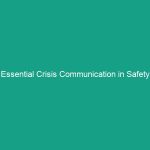Good morning team!
Today, we’re going to discuss a crucial aspect of our workplace: Essential Work Area Best Practices: Avoid These Common Safety Risks. Understanding and implementing these practices is vital for ensuring a safe Environment for everyone. By focusing on Safety, we not only protect ourselves but also our colleagues and the overall productivity of our workplace.
Understanding Essential Work Area Best Practices
When we talk about essential work area best practices, we refer to the guidelines and protocols that help maintain a safe working environment. These practices are not just a set of rules; they are fundamental to preventing accidents and injuries in the workplace. Ensuring adherence to these practices impacts our daily operations positively, fostering a culture of safety and efficiency.
Common misconceptions might suggest that safety Procedures are cumbersome or unnecessary. However, neglecting these essential practices can lead to severe consequences, including workplace injuries, legal repercussions, and a negative impact on morale.
Key Hazards, Risks, and Safety Considerations
Let’s take a closer look at some specific Hazards and risks associated with inadequate safety practices:
- Slips, Trips, and Falls: These are among the most common workplace accidents. Wet floors, cluttered walkways, and uneven surfaces can lead to serious injuries.
- Improper Use of Equipment: When tools and machinery are not used correctly, it can result in dangerous situations. Familiarity with equipment is crucial.
- Inadequate Personal Protective Equipment (PPE): Not wearing appropriate PPE can expose employees to hazardous materials and environments.
- Fire Hazards: Poorly maintained equipment and failure to follow fire safety protocols can lead to devastating incidents.
Ignoring safety protocols can lead to real-world consequences, including injuries that could have been easily avoided. It’s essential to recognize these risks and take proactive measures to mitigate them.
Best Practices, Procedures, & Actionable Advice
Now, let’s discuss some actionable best practices that everyone should implement:
1. Maintain Clean Work Areas
Keeping work areas tidy is crucial. Regularly clean up spills, remove clutter, and ensure pathways are clear. This simple practice can significantly reduce the risk of slips and falls.
2. Use Equipment Properly
Always follow the manufacturer’s instructions when using tools and machinery. Attend Training sessions to understand the proper use and Maintenance of equipment. For example, if you’re using a ladder, ensure it is stable and on a flat surface.
3. Wear Appropriate PPE
Always wear the necessary Personal Protective Equipment for your tasks. This may include helmets, gloves, eye protection, and hearing protection. Remember, PPE is your first line of defense against workplace hazards.
4. Follow Fire Safety Protocols
Be familiar with the fire safety plan, including the location of fire extinguishers and emergency exits. Participate in regular fire drills to ensure you know how to respond in case of an emergency.
5. Report Hazards Immediately
If you notice any unsafe conditions or practices, report them to your supervisor immediately. Quick reporting can prevent accidents and injuries before they occur.
For further understanding, let’s consider a brief case study. Last year, in a similar workplace, an employee sustained an injury due to a slip on a wet floor that had not been marked. This incident could have been avoided if proper signage and immediate cleanup had been prioritized.
Regulations, Standards, and Compliance
Following safety Regulations and Standards is not just best practice—it’s a legal requirement. Organizations must comply with OSHA (Occupational Safety and Health Administration) regulations and any other relevant safety standards, such as ISO certifications. Compliance ensures that we all work in a safe environment and helps protect the company from legal issues.
Understanding the rationale behind these regulations—such as protecting employees and reducing liability—can motivate adherence.
Employee Engagement & Discussion
Now, I’d like to open the floor for discussion. Here are a few questions to consider:
- What specific safety challenges have you encountered in your work area?
- Are there any safety practices that you believe could be improved?
- How can we support each other in maintaining a safer workplace?
These questions can lead to valuable insights and collective strategies to enhance our safety culture.
Conclusion & Key Takeaways
In conclusion, implementing essential work area best practices is fundamental in avoiding common safety risks. By maintaining clean workspaces, using equipment correctly, wearing appropriate PPE, adhering to fire safety protocols, and reporting hazards, we can create a safer work environment for everyone.
Let’s prioritize these practices and ensure that safety is at the forefront of our daily operations. Remember, safety is everyone’s responsibility, and together, we can make our workplace a safer place. Thank you for your attention and commitment to safety!


